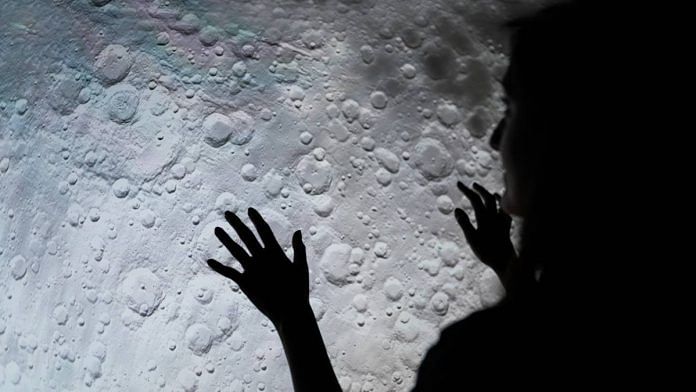Here’s a bit of news guaranteed to make you feel old: the Moon is rusting.
Seriously.
Earlier this month, researchers published evidence of hematite at the Moon’s higher latitudes, and hematite — or Fe2O3 — is an oxide of iron that turns red when it begins to rust. Hematite provides the rosy color on the surface of Mars. But the reddish cast to the Martian surface poses no mystery: astrophysicists are confident that there was once flowing water on Mars (and might still be today … or not).
The Moon is different. Why would there be rust on the lunar surface? We know there are trace amounts of water, and we know there’s plenty of iron, but where’s the oxygen coming from? And why is the rust heavily on the side of the moon facing us — that is, the side where the water isn’t?
The sci-fi fans among us, as well as various delightful kooks, would love the answer to be that an alien expedition — Trisolarans, anyone? — has been staging there while studying Earth and is starting to leave traces. The likely explanation is more prosaic, but by no means less impressive: the oxygen is coming from us.
Impact from space debris liberates deeply buried water molecules, and over hundreds of thousands of millennia, bits of Earth’s atmosphere have reached the lunar surface, almost 240,000 miles away.
How so?
Usually the Moon, like the rest of the solar system, is bathed in solar wind. But for five days out of every lunar orbit, the Moon is shielded from solar wind … by the Earth. In 2017, researchers studying the observations from Japan’s Kaguya spacecraft announced that during the periods when the Earth shielded the Moon, a high concentration of oxygen ions was found in the lunar soil. The simplest answer: an “Earth wind” effect, in which solar activity peels tiny particles from the atmosphere, many of which strike the lunar surface. The researchers suggest that this transfer of ions, including biogenic oxygen, might have been going on for over two billion years. That’s a truly exciting hypothesis. If true, it would mean that by studying the Moon’s crust, we’d be able to better map the physical and biological history of our own planet.
The Moon is the largest satellite in the Solar System in relation to the volume of the planet it circles — large enough, really, to be called a planet itself. Small wonder that human beings spent so much of history determined to reach it. Yet long before the Cold War race to see who could get there first, the Moon fascinated us. As Bernd Brunner reminds us in his 2010 volume “Moon: A Brief History,” human beings since the dawn of civilization have gazed with fascination on the glowing visitor in the night sky. The invention of time as something to be measured might have been related to the Moon’s appearances. The second-century Syrian writer Lucian (Brunner calls him Greek) imagined human beings already living there. The notion persisted. The more cultures later European explorers encountered, the more the West believed that the Moon must be inhabited. Even once we knew our neighbor was barren, the desire to get there drove a significant chunk of 20th-century science.
Scientists have never stopped studying the Moon, although nowadays their astonishing discoveries tend to be crowded out by Earth-bound headlines. We’ve known about the water since evidence was found in moon rocks brought back by the Apollo astronauts. Experiments carried in India’s spacecraft Chandrayaan-1 in 2008 found signs in the polar regions of absorption properties consistent with molecules that contain water.
But there’s a considerable gap between stray water molecules and enough oxygen ions to cause visible rust. Does the “Earth wind” theory seem plausible enough to explain the phenomenon? Perhaps rust on the Moon is best seen as a reminder of how much we still don’t know about our closest neighbor. After all, just last year, astronomers found an unexplained “blob” the size of Hawaii beneath the surface on the dark side.
Too bad we can’t take a quick run up there to look around. Turns out we don’t live in the warmly optimistic future imagined by Stanley Kubrick in his masterpiece “2001: A Space Odyssey.” In the film, the U.S. and a still-extant U.S.S.R. have together colonized the Moon, and traveling to the Moon is as easy as crossing the street — or, rather, as easy as hopping aboard the Pan Am space shuttle for a quick flight, with a stop along the way at a space station, where you can have drinks with friends in the Hilton lounge.
Alas, we never got there, and we’re headed the opposite way. We’ve come to look downward, and inward, taking the view more and more that the exploration of the cosmos — even near-Earth space — is a luxury we can no longer afford. Chances are that the next human beings to set foot on the lunar surface will be sent by private companies arguing over who gets to exploit the Moon’s bountiful mineral resources. An inevitable step, perhaps, but hardly the stuff of wonder and inspiration.
I’ve long argued that when we took our eyes off the heavens, we surrendered something that once awed and inspired us, an experience that filled us with childlike wonder. A rusting Moon won’t restore our lost wonder. But if the puzzle distracts us for just a few minutes, at least the distraction points us toward pondering our place in a vastly larger universe.-Bloomberg
Also read: Scientists discover three stars ripping apart their planet-forming disc






